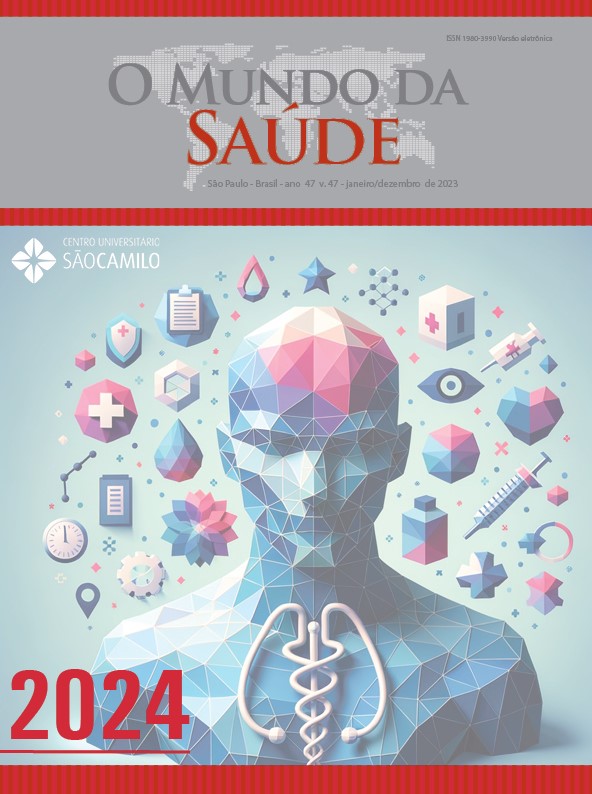X-linked chondrodysplasia punctata type 1 (CDPX1) - case report with atypical phenotype
DOI:
https://doi.org/10.15343/0104-7809.202448e15272023PKeywords:
Genetics, Chondrodysplasia Punctata, ChildAbstract
Chondrodysplasia punctata (CDP) is a group of bone dysplasias characterized by punctate calcifications in the cartilage, mainly epiphyseal. Among the various forms of CDP, the X-linked form is rare and has been described in 50 male patients in the literature. The aim of this study is to describe an atypical case of CDPX1 and compare it with previous literature. Preschooler, male, four years old, born full-term, small for gestational age and with no similar cases in the family. He developed disproportionate short stature, eutrophy, cervical and dorsal scoliosis with pectus carinatum, slight asymmetry in the lower limbs, ocular hypertelorism with blue-gray sclera and hair loss. He did not present fractures or bone pain and had neuropsychomotor development appropriate for his age. The exams showed no changes in the osteometabolic profile or in pituitary hormones. The karyotype was 46,XY and the genetic panel for skeletal dysplasias showed a hemizygous pathogenic variant in the ARSL gene (Arylsulfatase L) chrX:2.934.859 C>T (p.Trp581* ENST00000381134) diagnosed with X-linked chondrodysplasia punctata type 1. CDPX1 is directly related to the deficiency of ARSL enzyme activity, which can result in changes in neuropsychomotor development, hearing loss and episodes of respiratory failure. However, these characteristics were not presented by the proband. Thus, the proband has a milder form of CDPX1. Early diagnosis of skeletal dysplasias such as CDPX1 is important for adequate outpatient follow-up, family counseling and prevention of the development of long-term comorbidities.
Downloads
References
Irving MD, Chitty LS, Mansour S, Hall CM. Chondrodysplasia punctata: a clinical diagnostic and radiological review. Clin Dysmorphol. 2008 Oct;17(4):229-41. doi: 10.1097/MCD.0b013e3282f44043. PMID: 18799974.
Figueirêdo SS, Araújo JS, Kozan JEM, Santos NCL, Tanganeli V. Condrodisplasia punctata rizomélica: relato de caso e breve revisão da literatura. Radiologia Brasileira. 2007;40(1):69–72. doi: 10.1590/S0100-39842007000100018.
Braverman NE, Bober MB, Brunetti-Pierri N, Suchy SF. Chondrodysplasia Punctata 1, X-Linked. 2008 Apr 22 [updated 2020 Oct 15]. In: Adam MP, Mirzaa GM, Pagon RA, Wallace SE, Bean LJH, Gripp KW, Amemiya A, editors. GeneReviews® [Internet]. Seattle (WA): University of Washington, Seattle; 1993–2023. PMID: 20301713.
Schwartz NB, Domowicz M. Chondrodysplasias. In: Martini L, editor. Encyclopedia of Endocrine Diseases. Elsevier; 2004. p. 502-509. ISBN: 9780124755703.
Brunetti-Pierri N, Andreucci MV, Tuzzi R, Vega GR, Gray G, McKeown C, et al. X-linked recessive chondrodysplasia punctata: spectrum of arylsulfatase E gene mutations and expanded clinical variability. Am J Med Genet A. 2003 Mar 1;117A(2):164-8. doi: 10.1002/ajmg.a.10063. PMID: 12567415.
Daniele A, Parenti G, d'Addio M, Andria G, Ballabio A, Meroni G. Biochemical characterization of arylsulfatase E and functional analysis of mutations found in patients with X-linked chondrodysplasia punctata. Am J Hum Genet. 1998 Mar;62(3):562-72. doi: 10.1086/301764. PMID: 9497243; PMCID: PMC1376941.
Nino M, Matos-Miranda C, Maeda M, Chen L, Allanson J, Armour C, et al. Clinical and molecular analysis of arylsulfatase E in patients with brachytelephalangic chondrodysplasia punctata. Am J Med Genet A. 2008 Apr 15;146A(8):997-1008. doi: 10.1002/ajmg.a.32264. PMID: 18348268.
Ochiai D, Takamura K, Nishimura G, Ikeda T, Yakubo K, Fukuiya T. Prenatal diagnosis of cervical spinal cord compression in chondrodysplasia punctata brachytelephalangic type: A case report and literature review. Congenit Anom (Kyoto). 2013 Dec;53(4):160- 2. doi: 10.1111/cga.12053. PMID: 24712475.
Kim SJ, Lee SM, Choi JM, Jang JH, Kim HG, Kim JT, et al. Genetic analysis using a next generation sequencing-based gene panel in patients with skeletal dysplasia: A single-center experience. Front Genet. 2021;12:670608. doi: 10.3389/fgene.2021.670608.
Downloads
Published
How to Cite
Issue
Section
License
Copyright (c) 2024 O Mundo da Saúde

This work is licensed under a Creative Commons Attribution 4.0 International License.






























